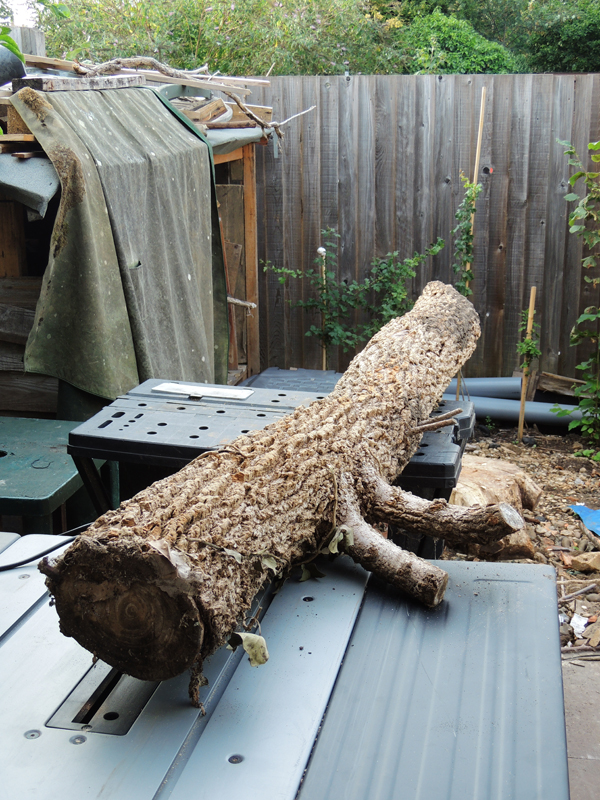This post is about making wood out of a tree, or "conversion" as it is known.
In the words of Blurt:
The tree is dead.
Long live the tree!
Back in 2018, our elm tree died. This was a shame. When we moved in, it was a good 20-plus feet high, leafy and alive. But the rot was already there and the long hot summer finished it off.
So, I chopped it down...
I was determined to use the wood though. It is not often you get your hands on elm and it is a lovely strong wood. First off I hacked off all the branches. These were surprisingly tough to detach and some of them needed the chainsaw, instead of just a machete.
The branches were later cut up for kindling, really good kindling. Elm is quite dense so it has plenty of calories tucked inside it and doesn't spit when alight.
After de-branching, the main trunks ended up looking like this.
I wanted to make full-length pieces, but due to the bend in this trunk, I decided to cut it into two parts.
Elm bark beetle tracks from under the bark. The beetles don't kill the tree directly. Their tracks allow a fungus to spread under the bark which causes the tree to block off affected cells. But, in doing so this starves off water and nutrients from higher areas of the tree, ultimately killing them. Sad face.
Here is one trunk, with the bark off. It had a pretty big split in it, it transpired.
Commercially this is done with massive circular saws or massive bandsaws. I had neither, only a small circular tablesaw.
The log was long, uneven and heavy. It was not going to be safe to try and cut it on the table saw.
To make it easier (and safer), I first planed one face flat with a power planer.
This allowed the flat plane to ride over the table. Without doing this, the log would roll about and put loads of strain on the saw bearings.
I've missed off a few shots of the rounded outer pieces being sawn off here. Here is the middle piece of the trunk being sawn on one side.
The saw blade cuts only to a depth of about 55mm, which is about half the thickness of the piece I had, once squared off. This meant I had to turn the piece over and saw through on the other side in a second pass on the table saw. It is not easy to do this perfectly in alignment. You can see some dodgy saw blade marks where one second pass was not quite cut in the same vertical plane as the first pass.
But, hey - I ended up with some quite nice chunky thick planks of elm.
Here are some of the planks.
Of course, they needed to be seasoned after this. Essentially the trunk is full of sap or otherwise wet and needs to be left for a long time to dry out and stabilise.
The logs themselves were seasoned whole in the shed, from when they were cut down in October 2018. They were sawn down into planks in four months later in January 2019. The timber from them was not used until a year later in January 2020.
















Hey, I know this guy! It's been quite a few years (Portland, 3D workshop?), but good to see you're still hacking away. You, sir, are an honorary New Mexican for your determination to use every bit of that fallen tree. We're losing elms left & right here. Most end up firewood, but those Blurt words & what you're at with this make it worth rethinking.
ReplyDeleteHey man. I totally missed this comment. How are you : )
ReplyDeleteI still make a load of stuff. Great to hear from you.